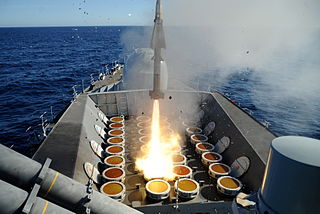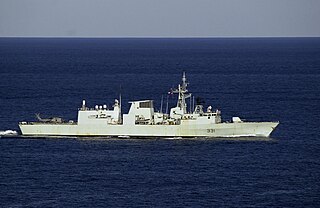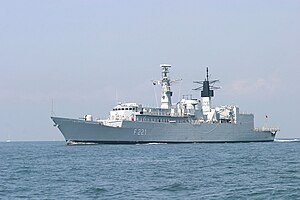Six ships of the British Royal Navy have been named Coventry, after the city of Coventry in the West Midlands.

HMS Montrose was the eighth of the sixteen-ship Type 23 or Duke class of frigates, of the Royal Navy, named after the Duke of Montrose. She was laid down in November 1989 by Yarrow Shipbuilders on the Clyde, and was launched on 31 July 1992 by Edith Rifkind, wife of Malcolm Rifkind, Secretary of State for Defence. She was commissioned into service in June 1994.

The Type 22 frigate also known as the Broadsword class was a class of frigates built for the British Royal Navy. Fourteen were built in total, with production divided into three batches.

Regina Maria (F222) is a Type 22 frigate of the Romanian Naval Forces, formerly a Royal Navy ship named HMS London (F95). It is named after Queen Marie of Romania, wife of King Ferdinand I of Romania.

HMS Glasgow was a Type 42 destroyer of the Royal Navy. The last of the Batch 1 Type 42 destroyers, Glasgow was commissioned in 1979. The destroyer fought during the Falklands War, and on 12 May 1982 was damaged by a bomb from an Argentine A-4 Skyhawk. Glasgow was part of the Royal Navy’s 3rd Destroyer Squadron along with HMS York, HMS Edinburgh and HMS Liverpool. The 3rd Destroyer Squadron was based in Rosyth during the 1980s and early 1990s before being moved to Portsmouth when Rosyth Dockyard was privatised and re-purposed. The destroyer was decommissioned in 2005 and was broken up for scrap in 2009.

HMCS Toronto is a Halifax-class frigate that has served in the Canadian Forces since 1993. Toronto is the fourth ship in her class which is the name for the Canadian Patrol Frigate Project. She is the second RCN ship to be named for Canada's largest city. When not on operations, she is assigned to Maritime Forces Atlantic (MARLANT) and is based at CFB Halifax. Toronto serves on MARLANT missions protecting Canada's sovereignty in the Atlantic Ocean and enforcing Canadian laws in its territorial sea and exclusive economic zone.

Sea Wolf is a naval surface-to-air missile system designed and built by BAC, later to become British Aerospace (BAe) Dynamics, and now MBDA. It is an automated point-defence weapon system designed as a short-range defence against both sea-skimming and high angle anti-ship missiles and aircraft. The Royal Navy has fielded two versions, the GWS-25 Conventionally Launched Sea Wolf (CLSW) and the GWS-26 Vertically Launched Sea Wolf (VLSW) forms. In Royal Navy service Sea Wolf is being replaced by Sea Ceptor.

The Type 26 frigate, also known as City-class frigate, is a class of frigates and destroyers being built for the United Kingdom's Royal Navy, with variants also being built for the Australian and Canadian navies. The programme, known as the Global Combat Ship, was launched by the British Ministry of Defence to partially replace the navy's thirteen Type 23 frigates, and for export. Its primary role is to conduct advanced anti-submarine warfare missions while supporting air defence and general purpose operations. The type is the first naval platform shared between Australia, Canada and the United Kingdom since the pre-Second World War Tribal-class destroyer.

Standing Royal Navy deployments is a list of operations and commitments undertaken by the United Kingdom's Royal Navy on a worldwide basis. The following list details these commitments and deployments sorted by region and in alphabetical order. Routine deployments made by the Navy's nuclear-powered submarines and their location of operations is classified.

The Romanian Naval Forces is the principal naval branch of the Romanian Armed Forces and operates in the Black Sea and on the Danube. It traces its history back to 1860.

HMCS Vancouver is a Halifax-class frigate, of the Royal Canadian Navy launched on 8 July 1989, as the second vessel of her class. She is based at CFB Esquimalt on the west coast of Canada, and is the third vessel to be named after Vancouver, British Columbia.

HMCS Calgary is a Halifax-class frigate that has served in the Canadian Forces and Royal Canadian Navy since 1995. Calgary is the sixth vessel in her class and the second vessel to carry the name Calgary. She was built as part of the Canadian Patrol Frigate Project. Calgary began the FELEX refit in June 2012. She is assigned to Maritime Forces Pacific (MARPAC) and is homeported at CFB Esquimalt. Calgary serves on MARPAC missions protecting Canada's sovereignty in the Pacific Ocean and enforcing Canadian laws in its territorial sea and exclusive economic zone.

HMCS Charlottetown is a Halifax-class frigate that has served in the Royal Canadian Navy since 1995. Charlottetown is the tenth ship in her class which is based on the Canadian Patrol Frigate Project. She is the third vessel to carry the designation HMCS Charlottetown. Charlottetown, assigned to Maritime Forces Atlantic (MARLANT) and homeported at CFB Halifax, serves on missions protecting Canada's sovereignty in the Atlantic Ocean and enforcing Canadian laws in its territorial sea and exclusive economic zone. Charlottetown has also participated in several NATO missions, patrolling the Atlantic Ocean as part of Standing Naval Force Atlantic (STANAVFORLANT) and its successors Standing NATO Maritime Group 1 and 2. Charlottetown has also been deployed on missions throughout the Atlantic and to the Indian Ocean, specifically the Persian Gulf and Arabian Sea on anti-terrorism operations.

Underway replenishment (UNREP) or replenishment at sea (RAS) is a method of transferring fuel, munitions, and stores from one ship to another while under way. First developed in the early 20th century, it was used extensively by the United States Navy as a logistics support technique in the Pacific theatre of World War II, permitting U.S. carrier task forces to remain at sea indefinitely.

RFA Wave Knight is a Wave-class fast fleet tanker of the Royal Fleet Auxiliary (RFA) of the United Kingdom tasked with providing fuel, food, fresh water, ammunition and other supplies to Royal Navy vessels around the world.

Operation Unified Protector was a NATO operation in 2011 enforcing United Nations Security Council resolutions 1970 and 1973 concerning the Libyan Civil War and adopted on 26 February and 17 March 2011, respectively. These resolutions imposed sanctions on key members of the Gaddafi government and authorized NATO to implement an arms embargo, a no-fly zone and to use all means necessary, short of foreign occupation, to protect Libyan civilians and civilian populated areas.

Destroyer Squadron 60 is a destroyer squadron of the United States Navy. Destroyer Squadron 60 is one of three U.S. Navy destroyer squadrons permanently based outside the continental United States.

NMS Mărășești was one of four Vifor-class destroyers ordered by Romania shortly before the beginning of the First World War from Italy. All four sister ships were requisitioned when Italy joined the war in 1915. Originally named Vârtej by the Romanians, she was renamed Nibbio and classified as a scout cruiser in Italian service. Not completed until mid-1918, the ship took part in the Adriatic campaign of World War I but engaged Austro-Hungarian Navy ships in the Adriatic Sea only once before the war ended in November 1918. She was renamed Mărășești when she was re-purchased by the Romanians in 1920.

NMS Regina Maria was the second and last of the two Regele Ferdinand-class destroyers built in Italy for the Romanian Navy in the late 1920s. After the Axis invasion of the Soviet Union on 22 June 1941, she took part in the Raid on Constanța a few days later and may have damaged a Soviet destroyer leader during the battle. The powerful Soviet Black Sea Fleet heavily outnumbered Axis naval forces in the Black Sea and the Romanian destroyers were limited to escort duties in the western half of the Black Sea during the war. In early 1944 the Soviets were able to cut off and surround the port of Sevastopol on the Crimean Peninsula. Regina Maria covered convoys evacuating Axis troops from Sevastopol in May and rescued several hundred herself.
Regele Ferdinand was the name of at least two ships of the Romanian Navy and may refer to:
























